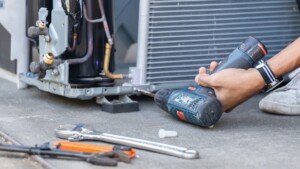 When asked “what is air conditioner service?,” too many homeowners don’t know how to answer. Air conditioner service refers to the maintenance and repair necessary to keep your AC operating effectively. Service should be carried out at least once a year, more often if you live in a particularly hot climate where you’re likely to run your AC more often. Unless you’ve been trained on HVAC systems, it’s best to hire a professional rather than do the work yourself. A complete service visit involves:
When asked “what is air conditioner service?,” too many homeowners don’t know how to answer. Air conditioner service refers to the maintenance and repair necessary to keep your AC operating effectively. Service should be carried out at least once a year, more often if you live in a particularly hot climate where you’re likely to run your AC more often. Unless you’ve been trained on HVAC systems, it’s best to hire a professional rather than do the work yourself. A complete service visit involves:
Cleaning Coils and Filters
Air conditioners don’t just cool the air in your home. They filter it as well, trapping dust, dirt, and dander that has been sucked down into the return vents. However, over time, the accumulated debris can begin to restrict airflow and strain your system. To ensure efficient cooling, HVAC technicians will check the filter and swap it out if it’s clogged with grime.
At the same time, they’ll wipe down the evaporator and condenser coils responsible for removing and dispersing heat. Even a relatively thin layer of dirt is enough to affect the unit’s performance and reduce the amount of cool air inside your home.
Inspecting Critical Components
Inspections prevent minor issues from escalating into major problems. HVAC technicians look for damage to the compressor, condenser, blower fan, thermostat, air handler, expansion valve, refrigerant lines, and evaporator coils. If they’re impaired, it could lead to:
- Electrical Faults. Loose wires, frayed insulation, and bad connections can short out your unit and possibly damage other parts of your home.
- Frozen Coils. Leaks, clogged drains, broken fans, and malfunctioning thermostats can lower temperatures inside your air conditioner to the point that it freezes over.
- Airflow Problems. The blower fan is responsible for circulating air through your home. However, as it wears out, the air stream gradually falls off, reducing performance.
- Higher Electric Bills. Weak compressors have a hard time pumping refrigerant through the system. As a result, heat transfers become less efficient and cooling cycles become longer, leading to higher costs.
- Cycling Troubles. Inaccurate temperature readings and defective controls can prevent the air conditioner from shutting off once it reaches your desired temperature or from switching on when temperatures rise above your desired level.
Checking Refrigerant Levels
Refrigerant is the most important component of your air conditioner, responsible for transferring heat from inside to outside your home. Unless your AC was installed by an untrained or unqualified HVAC technician, it’s rare for refrigerant to be too high. Low refrigerant, on the other hand, is a common problem. When refrigerant levels drop, it leads to insufficient cooling, icy coils, and higher energy costs. It can even damage your compressor, one of the most important and expensive parts of your air conditioning system.
Low refrigerant is normally caused by a leak in the lines connecting the condenser and evaporator. If a technician finds your refrigerant is below the recommended level, they’ll use ultraviolet dye and electronic leak detectors to track down the source of the problem. Then, once the leak has been sealed, they’ll recharge your system.
Testing Your System
In addition to their inspection, HVAC techs also gauge your air conditioner’s performance, to make sure it’s operating correctly. This involves:
- Verifying that the safety and pressure switches are functional and responsive.
- Assessing airflow through the supply and return vents, to make certain there aren’t any obstructions or impediments.
- Monitoring the air conditioner as it cycles on and off, ensuring that it activates, operates, and shuts down as intended.
- Examining the condensate line for clogs and obstructions, which prevents water from backing up and damaging your system.
- Checking the thermostat to ensure it can sense temperature changes and signal the air conditioning system to cycle on and off as needed.
- Calculating your system’s Delta T, the temperature difference between the air entering the evaporator and the air leaving the condenser. High Delta T indicates poor airflow, while a low Delta T indicates poor cooling performance.
Carrying Out Repairs
If the technician notices any significant issues, they’ll repair or replace the worn parts and patch up any leaks. Once the system is restored, an additional test will be performed, to ensure the unit is capable of maintaining a comfortable temperature throughout your home.
Save on Repairs with Agway EnergyGuardTM
Air conditioners are one of the hardest working systems in your home and subject to a high degree of wear and tear. Home insurance doesn’t cover this type of damage, but Agway does. Our EnergyGuardTMprogram protects your furnace, central air conditioning, and internal wiring from depreciation caused by regular use.*
When the need for repair occurs, our customers don’t waste time searching for a qualified technician. They call us instead. We maintain a large network of local contractors and as soon as we get your call, we send out the first one available. There are no service fees or deductibles either. We pay for the visit and all covered parts. Don’t let a malfunction upset your household budget. Sign up and start enjoying the benefits of EnergyGuardTM today!